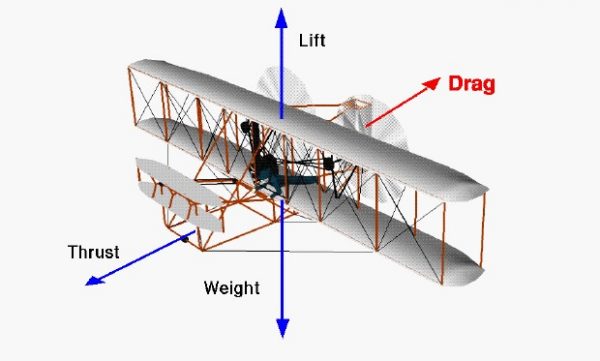Drag

Drag is the aerodynamic force that opposes an aircraft’s motion through the air. Drag is generated by every part of the airplane, even the engines. How is drag generated?
Drag is a mechanical force. It is generated by the interaction and contact of a solid body with a fluid (liquid or gas). It is not generated by a force field, in the sense of a gravitational field or an electromagnetic field, where one object can affect another object without being in physical contact. For drag to be generated, the solid body must be in contact with the fluid. If there is no fluid, there is no drag. Drag is generated by the difference in velocity between the solid object and the fluid. There must be motion between the object and the fluid. If there is no motion, there is no drag. It makes no difference whether the object moves through a static fluid or whether the fluid moves past a static solid object. Drag acts in a direction that opposes the motion. (Lift acts perpendicular to the motion.)
While many of the factors that affect lift also affect drag, there are some additional sources of aircraft drag.
We can think of drag as aerodynamic friction, and one of the sources of drag is the skin friction between the molecules of the air and the solid surface of the aircraft. Because the skin friction is an interaction between a solid and a gas, the magnitude of the skin friction depends on properties of both solid and gas. For the solid, a smooth, waxed surface produces less skin friction than a roughened surface. For the gas, the magnitude depends on the viscosity of the air and the relative magnitude of the viscous forces to the motion of the flow, expressed as the Reynolds number. Along the solid surface, a boundary layer of low energy flow is generated and the magnitude of the skin friction depends on the state of this flow.
We can also think of drag as aerodynamic resistance to the motion of the object through the fluid. This source of drag depends on the shape of the aircraft and is called form drag. As air flows around a body, the local velocity and pressure are changed. Since pressure is a measure of the momentum of the gas molecules and a change in momentum produces a force, a varying pressure distribution will produce a force on the body. We can determine the magnitude of the force by integrating (or adding up) the local pressure times the surface area around the entire body. The component of the aerodynamic force that is opposed to the motion is the drag; the component perpendicular to the motion is the lift.
There is an additional drag component caused by the generation of lift. Aerodynamicists have named this component the induced drag. This drag occurs because the flow near the wing tips is distorted span wise as a result of the pressure difference from the top to the bottom of the wing. Swirling vortices are formed at the wing tips, and there is an energy associated with these vortices. The induced drag is an indication of the amount of energy lost to the tip vortices. The magnitude of induced drag depends on the amount of lift being generated by the wing and on the wing geometry. Long, thin (chordwise) wings have low induced drag; short wings with a large chord have high induced drag.
All of the factors that affect aircraft drag can be combined into a single mathematical drag equation which can be used to predict aircraft performance. At the time of the Wright brothers, a slightly different version of the drag equation was used.
The Wright brothers learned about induced drag the hard way. Following their first glider flights of 1900, they knew that they had to increase the size of their wings to allow flight in reasonable winds. For the 1901 aircraft they increased the chord of the wing but kept the span nearly the same. This produced a wing with high induced drag. The brothers had made mathematical predictions of the performance of their aircraft. But the 1901 aircraft did not meet their range predictions because of lower than expected lift and higher than expected drag. During the winter, with the aid of their wind tunnel, they began to understand the role of high induced drag on their aircraft’s poor performance. They then designed the 1902 aircraft to have a longer span and shorter chord than the 1901 aircraft. The 1902 aircraft was able to meet their performance goals and paved the way for the 1903 Flyer.
